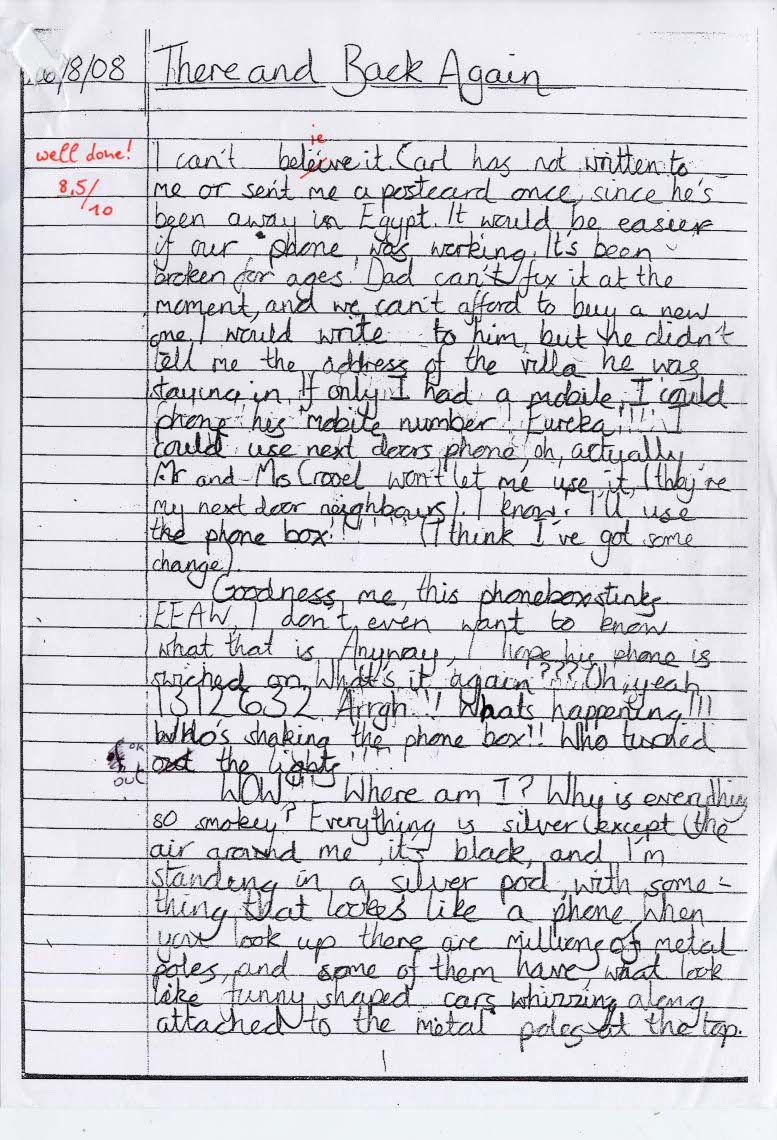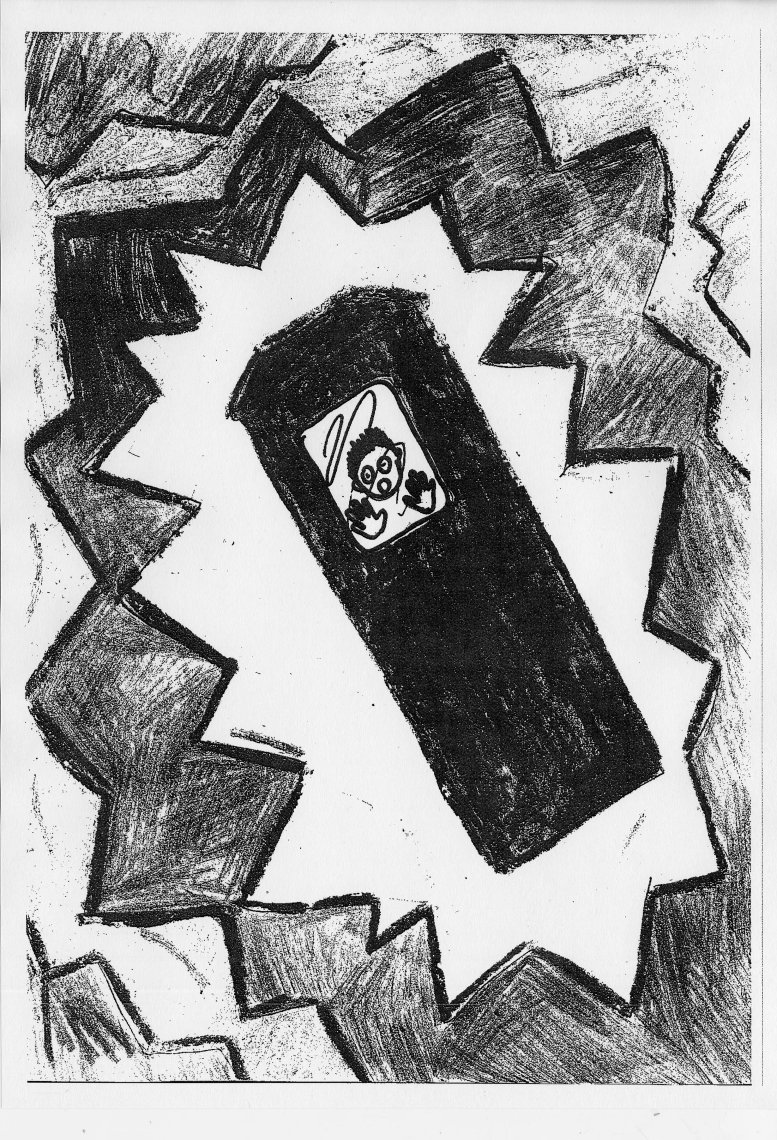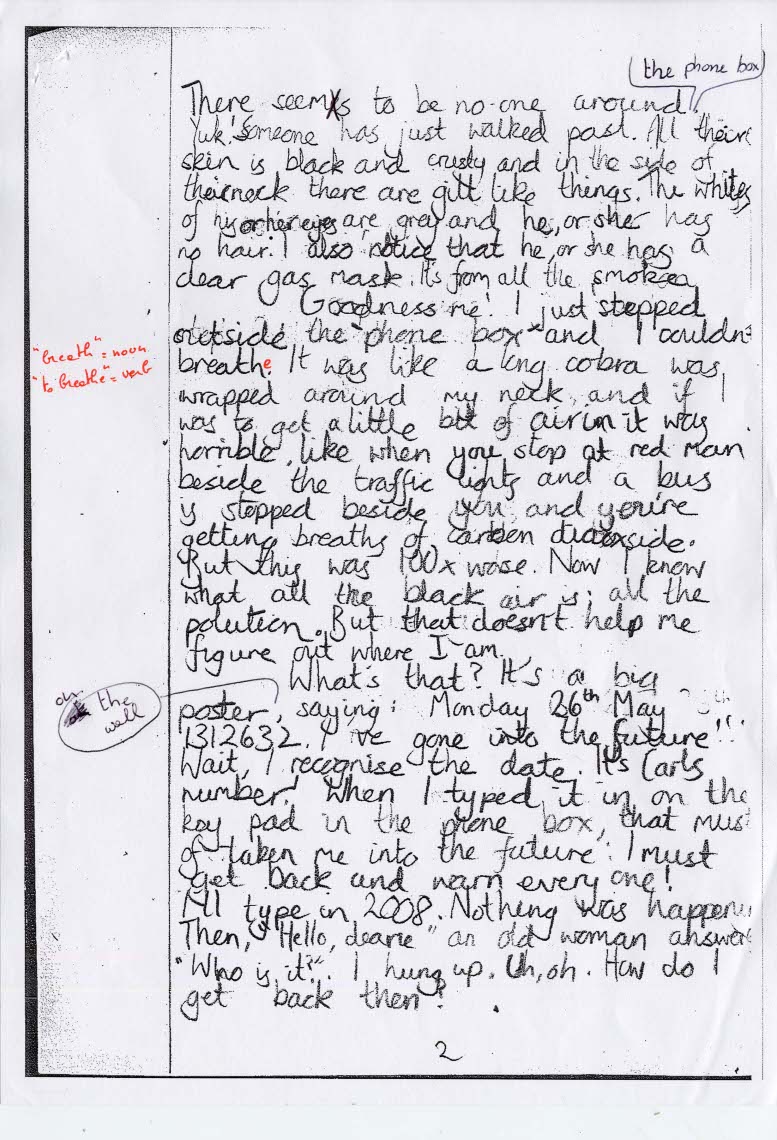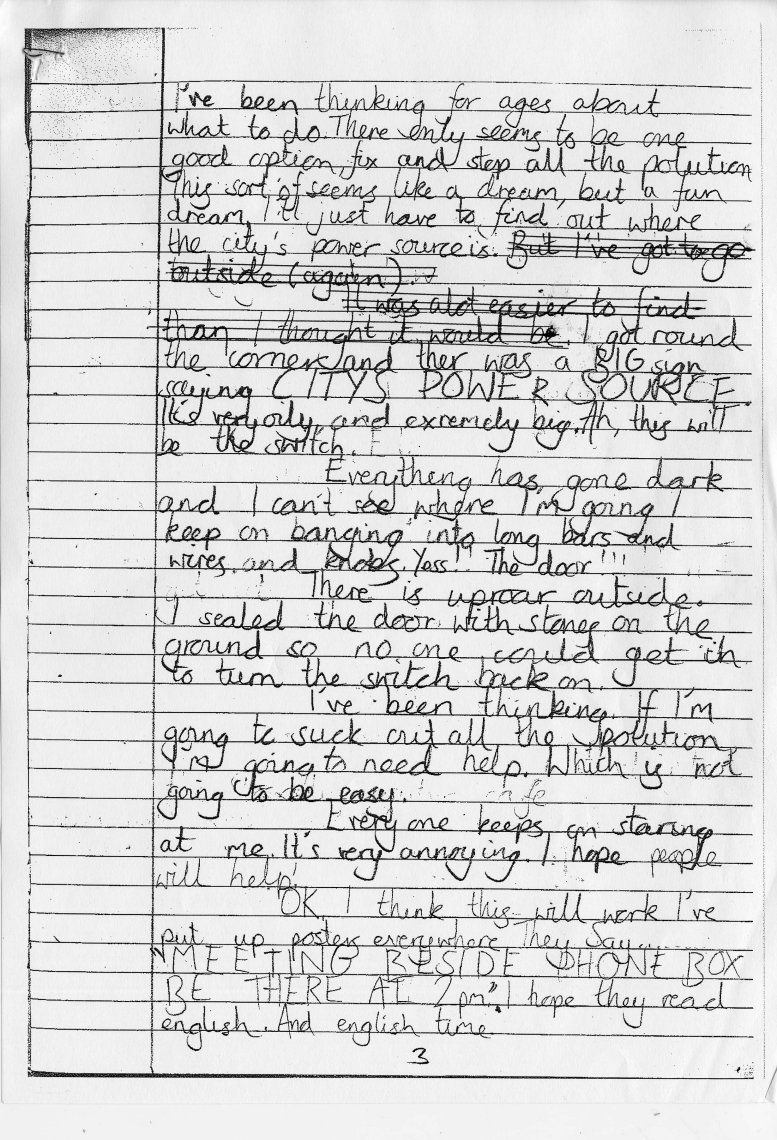In primary sources, prominent traces of the editing process are additions and deletions. Additions may be marked by differing positioning, shifts in hands, ink, or font, and can be explicitly indicated by all kinds of markers. Deletions are often visible as struck out text. Because they may shed light on the writing process of the text or hold alternative readings and interpretations, additions and deletions can be very valuable elements in an electronic transcription.
3.1.1. Simple Additions and Deletions #
Our sample text contains a clear addition at the top of the second page. The phrase “the phone box” has probably been added afterwards, as it didn’t fit in the space available. This can be transcribed as an addition with the <add> element (from “addition”).
Similarly, deletions can be marked with a specific element: <del> (from “deletion”). If we look closely at the same sentence, we see how the author has corrected a writing mistake by striking through a letter. This can be transcribed as follows:
Notice how additions, just like deletions, can be transcribed at character level, so that they enclose exactly those letters or phrases that have been deleted or added. We can be more precise about how additions and deletions are realised. Actual rendition information can be specified in the global @rend attribute. For example, we could use the @rend attribute to state that the deleted text has been crossed out, and the addition has occurred above the line, possibly using some kind of formalised expression. For deletions, information like "strikethrough" or "overwritten" may be sufficient (you can craft your own typology). Additionally, the <add> element has a specific attribute to record the place where the text had been added: @place. It can combine keywords like "below" or "above" for text added below or above the line; "bottom", "margin", or "top" for text added at the bottom, margin, or top of the page; "opposite" or "overleaf" for additions on the opposite page or at the other side of the page. Our example could be extended as follows:
Often, additions and deletions can be traced by shifts in ink or writing material. As this information can convey useful insights in the writing process, it can be useful to include it in the transcription. Of course, the @rend attribute could be used for this purpose, but <add> and <del> have a more sophisticated mechanism to record aspects of the hand in which they are written: the @hand attribute. This attribute in itself doesn’t indicate any specific features directly, but rather holds a reference to a hand description elsewhere in the document. A hand can be defined in a <handNote> element in the <profileDesc> part of the TEI header, which groups different hand definitions inside a <handNotes> element. A <handNote> definition can contain a loose prose description of the hand inside paragraphs, as well as more formalised identifications of different aspects of the hand in specific attributes: @scribe (an name for the scribe), @script (the writing style or font of a hand), @medium (the type of ink), and @scope (the dominance of this hand in the document). In order to make references to such a hand definition elsewhere in the transcription, a unique @xml:id value must be provided. Inside “transcriptional” elements such as <add> and <del>, reference to a hand definition can be made with the @hand attribute. As with all references in TEI, this takes the form of an URI pointer, of which the local part is preceded with a # sign. For this example, more details about the hand could be given as follows:
Notice how the @hand attribute is the means to distinguish between additions or deletions in a text made by different persons, if they can be distinguished. Our sample text contains other interventions in a different ink, made by a different hand. For example, on page two, text has been added both in the margin and inline, near the original word “breath.” A detailed study of the genesis of this work could identify the person responsible for these additions as the author’s teacher. With proper identification of this hand in the header, this attribution can be recorded in the transcription:
Notice how, although the content of both <add> elements was most probably added in the same addition, they are split in order to capture the different positioning on the page. Another thing of notice, is the slight abstraction that has been made of the actual occurrence of the marginal addition on the page: instead of interrupting the words “couldn’t breath,” the encoder has opted to transcribe the annotation at the end of the sentence. The inline addition, on the other hand, is transcribed where it appears in the original, and therefore not specified with a @place attribute.
Additions and deletions may come in isolation like in the examples above, but often occur in combination, when existing text is deleted and new text is added. Such a case of juxtaposed deletion and addition can be found on the second page of the example, in the word that should read “dioxide.” Apparently, a first version was started correctly, with “diox,” which the author has revised to “diacxside,” by overwriting the original “ox” and adding the “acx,” resulting in the final reading “diacxside.” This can be represented with a simple sequence of <del> and <add>:
Such combinations of deletions and deletions can be grouped in a dedicated <subst> (substitution) element, in order to identify them as a single editorial intervention.
Notice, how the identification of the responsible hand in the @hand attribute has been moved upward to the <subst> element. Because <subst> contains a deletion and addition by the same hand, the hand identification is inherited by the corresponding <del> and <add> elements in the transcription.
It must be acknowledged, that this analysis of the word “dioxide” in the text involves a fair amount of interpretation. Responsibility for these kinds of interpretation can be taken by means of a dedicated @resp (responsibility) attribute. It can occur on <add>, <del>, and <subst> elements, and points to an identified person in the TEI header of an electronic document. In this case, the TBE crew, who edited this electronic text, can be held responsible for this interpretation as follows:
Similarly, for the addition and correction in the first sentence on the first page, the authority can be indicated with @hand, and the responsibility for the identification of this addition with @resp:
Summary
Additions and deletions can be encoded with the
<add> and
<del> elements, respectively. While the
@rend attribute can be used to record general visual aspects of their realisation in the source, the
<add> element has a specific
@place attribute. This can be used to indicate where the addition is located (e.g.,
"inline",
"above" or
"below" the line; at the
"bottom" or
"top" of the page; in the
"margin",
"overleaf", on the
"opposite" page). Specific characteristics of the hand can be encoded by referring to a hand definition in the header, using the
@hand attribute, while responsibility for the encoding of additions and deletions can be stated in the
@resp attribute, referring to an identified person in the TEI header. Sequences of deletions and additions originating from one single intervention can be wrapped in a
<subst> element.
3.1.2. Complex Additions and Deletions #
Deletions and additions are not limited to a single “layer” of a document, as in the previous examples. They may as well nest, when, for example, an added fragment itself contains further deletions and/or additions. Take, for example, the fragment on page 2 of the example text, that originally read: “It’s a big poster, saying: ….” The author later had added the phrase “at the wall” in the margin, but has later corrected this to “on the wall.” This can be encoded as a single addition (“at the wall”), containing a nesting substitution, consisting of a deletion (“at”) and an addition (“on”):
Besides substitutions, often in hand written texts, an original reading can be restored after being rejected first. The TEI Guidelines provide a specific element for marking such restorations: <restore>. This element can be wrapped around prior deletions. Take, for example, the phrase that should read “Who turned out the lights!!!” on the first page in the example. This had first been substituted for “Who turned off the lights!!!” but has afterwards been restored to the original reading, indicated both by an “OK” marker, and the addition of the original word “out”:
Apart from having internal structure themselves, additions and deletions may overlap with other logical structures of a text, for example when crossing a paragraph boundary, or a phrase that is transcribed as a name or title. Take a look, for example, at page 3 of the sample document, which features two entire sentences being crossed out. This deletion, however, runs over two paragraphs. This could impossibly be encoded with a simple deletion:
That is, the markup itself (a paragraph boundary) is involved in the deletion, and can not just be enclosed in another container, which would produce overlapping hierarchies as in the previous incorrect example. Other cases that would result in invalid TEI occur when long deletions or additions that nest properly inside bigger structures encompass text structures that are illegal inside <add> or <del> (such as entire paragraphs or divisions: <add> and <del> can only contain phrase-level elements). In order to facilitate the encoding of such cases (that are to be expected, given the tension between the unedited nature of primary sources and the formalism of the TEI markup vocabulary), the TEI Guidelines provide two specific elements: <delSpan> and <addSpan>. These are empty elements marking the beginning of a longer deletion or addition, respectively. The scope of the addition or deletion is made explicit by means of a specific @spanTo attribute, which points to an identified end point, which comes later in the transcription. This end point can be represented with an empty <anchor> element, which is an all-purpose empty element for identifying a certain point in a text, via its @xml:id attribute. Although they can’t contain any text, <addSpan> and <delSpan> can have all attributes of their <add> and <del> counterparts. The deletion in the example document can thus be encoded as follows:
Summary
Complex deletions and additions may be represented using nesting
<del> and
<add> elements. Deleted text that has been restored again can be encoded with a
<restore> element. When deletions or additions contain logical structures that cannot be transcribed as valid content of the
<del> or
<add> elements, or cross structural boundaries that would lead to overlapping hierarchies, these can be represented with empty elements. The
<delSpan> and
<addSpan> elements can indicate the start of such deletions or additions, respectively, and point to their end point with a
@spanTo attribute. The value of this attribute must point towards a following
<anchor> element, which is an empty element identifying a point in the document with its
@xml:id attribute.







